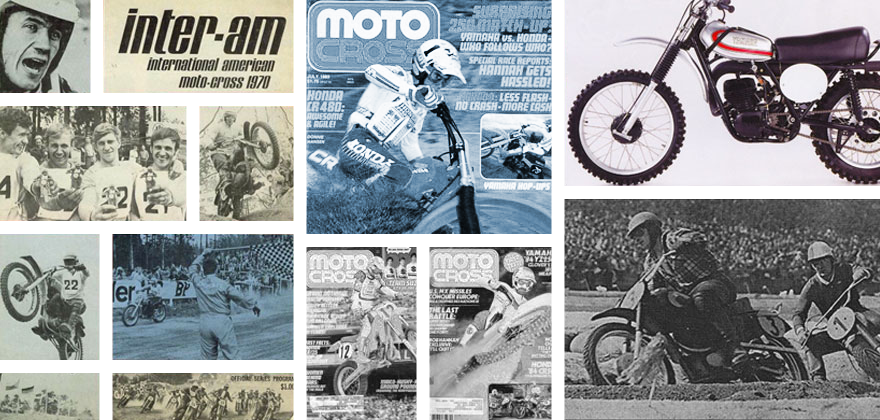
For this edition of Classic Steel, we are going to take a look back at how the 250 class of 1991 stacked up in the magazine shootouts of the time.
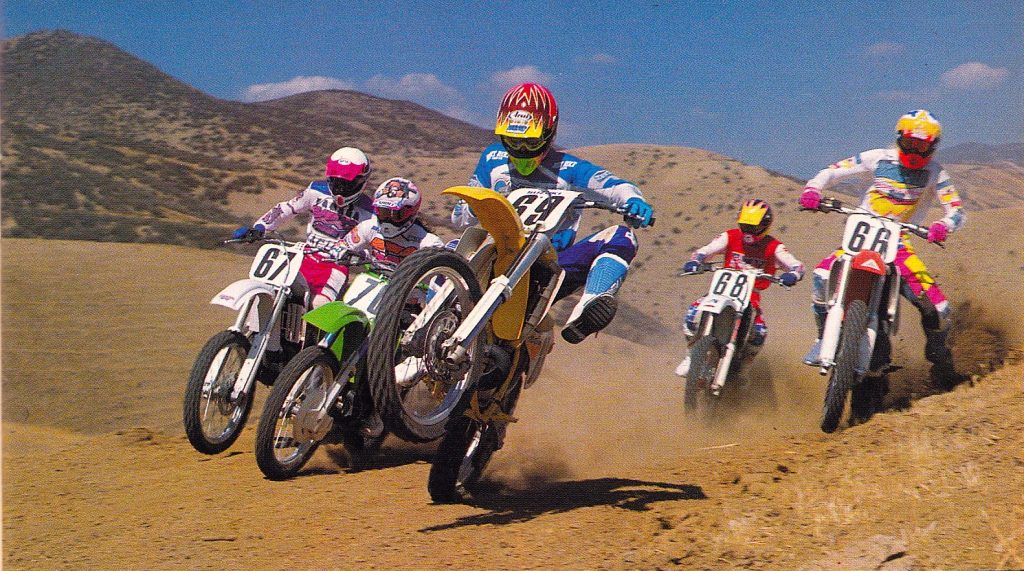 None of the 250 contenders were uncompetitive machines in 1991. Photo Credit: Dirt Bike
None of the 250 contenders were uncompetitive machines in 1991. Photo Credit: Dirt Bike
The early nineties were a great time to be racing in the 250 class. After two incredible decades of innovation in the 1970s and 1980s, the 1990s were more about refinement rather than reinvention. By 1990, the basic blueprint for the modern motocross machine was firmly in place with all the machines offering powerful liquid-cooled two-stroke motors with variable exhaust ports and electronic ignitions. Suspension design was largely settled as well with all the major manufacturers moving to inverted cartridge forks and linkage-equipped single-shock rear suspension systems putting out around 12 inches of travel. All five major players featured tough chromoly steel frames for strength and powerful dual discs front and rear.
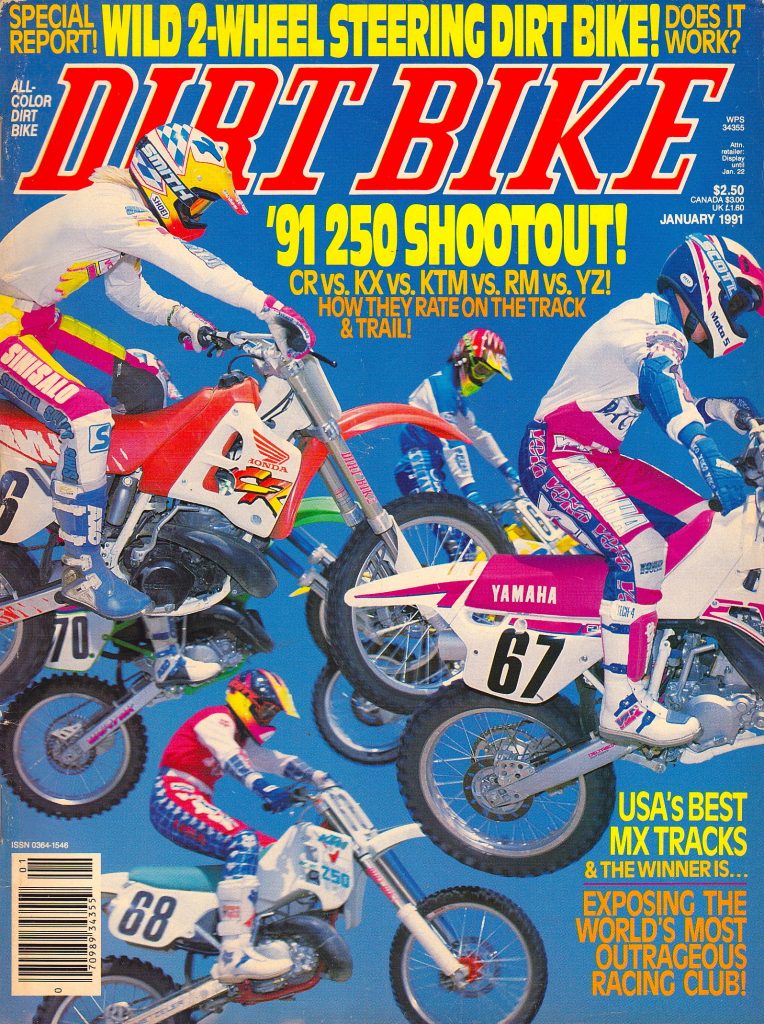 Dirt Bike’s graphics department used a bit of pre-Photoshop trickery to cram all of the 250 challengers onto the cover in 1991. Photo Credit: Dirt Bike
Dirt Bike’s graphics department used a bit of pre-Photoshop trickery to cram all of the 250 challengers onto the cover in 1991. Photo Credit: Dirt Bike
With all the machines more alike than ever, there was far more parity than there had been in the past. None of the 1991 contenders were terrible machines and the difference between the best and worst bikes often came down to personal preferences for size, power, and suspension feel. None of the bikes were too slow, too unreliable, or too far off the suspension mark to be considered a contender. There were certainly standouts in each area, but unlike a decade before, there was not a complete bowser in the bunch.
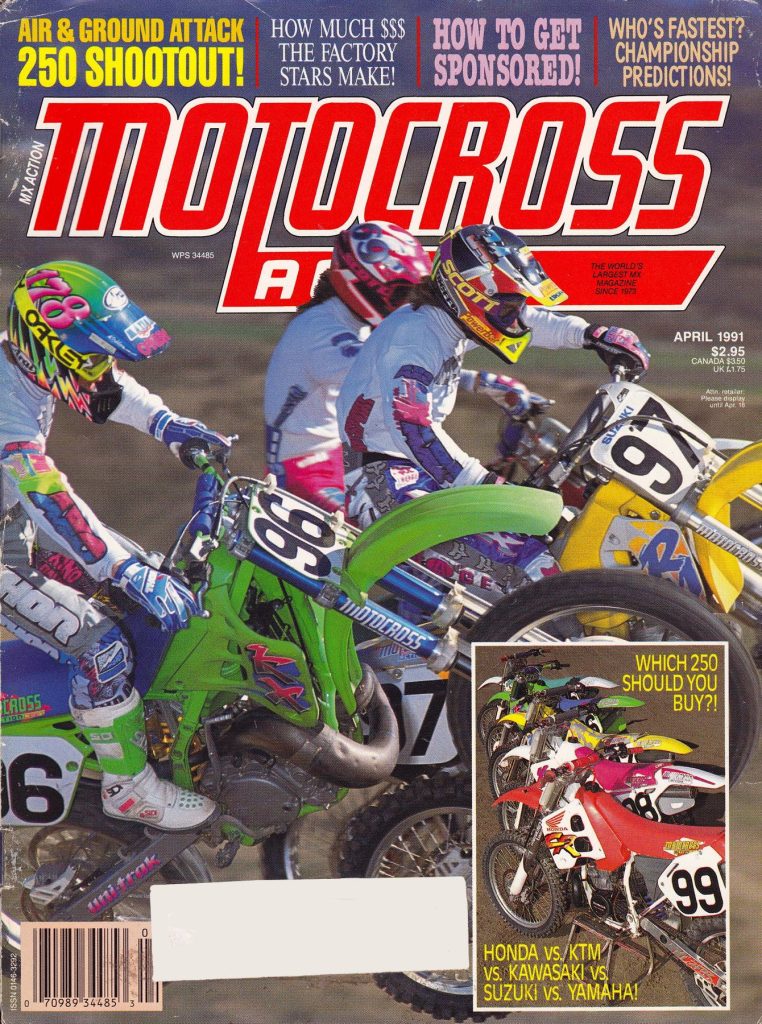 Motocross Action also put the 250 shootout front and center on the cover of their April 1991 Issue. Photo Credit: Motocross Action
Motocross Action also put the 250 shootout front and center on the cover of their April 1991 Issue. Photo Credit: Motocross Action
In 1991, this was most noticeable in the case of the Cycle News shootout, where they opened the test with “Take your pick” and failed to even crown a winner. Instead, they listed four testers’ thoughts with two riders picking the upstart KTM as best and the other two split between the Yamaha and Kawasaki. The fact that a KTM was even in the conversation of best 250 was big news in 1991, as the brand had typically been lambasted in the US press for its poor suspension setup and unique “Euro” feel.
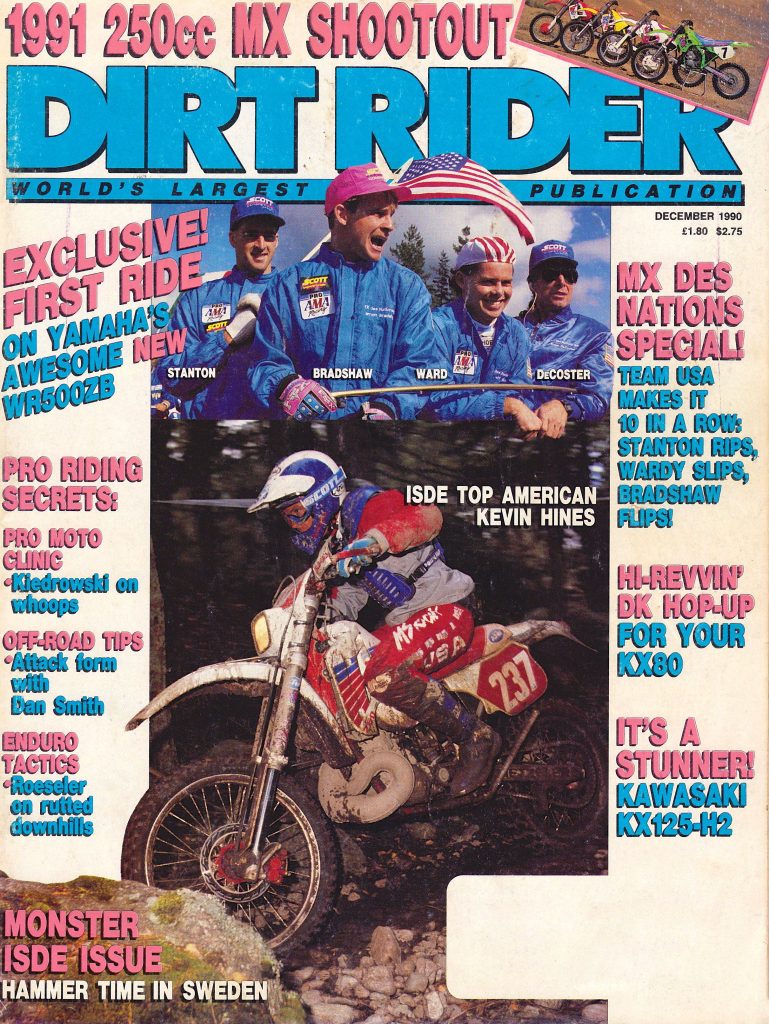 Motocross was never the sole focus for Dirt Rider and that is made pretty clear by the fact that off-road hero Kevin Hines gets a much more prominent spot on the cover than the 1991 250 shootout. Photo Credit: Dirt Rider
Motocross was never the sole focus for Dirt Rider and that is made pretty clear by the fact that off-road hero Kevin Hines gets a much more prominent spot on the cover than the 1991 250 shootout. Photo Credit: Dirt Rider
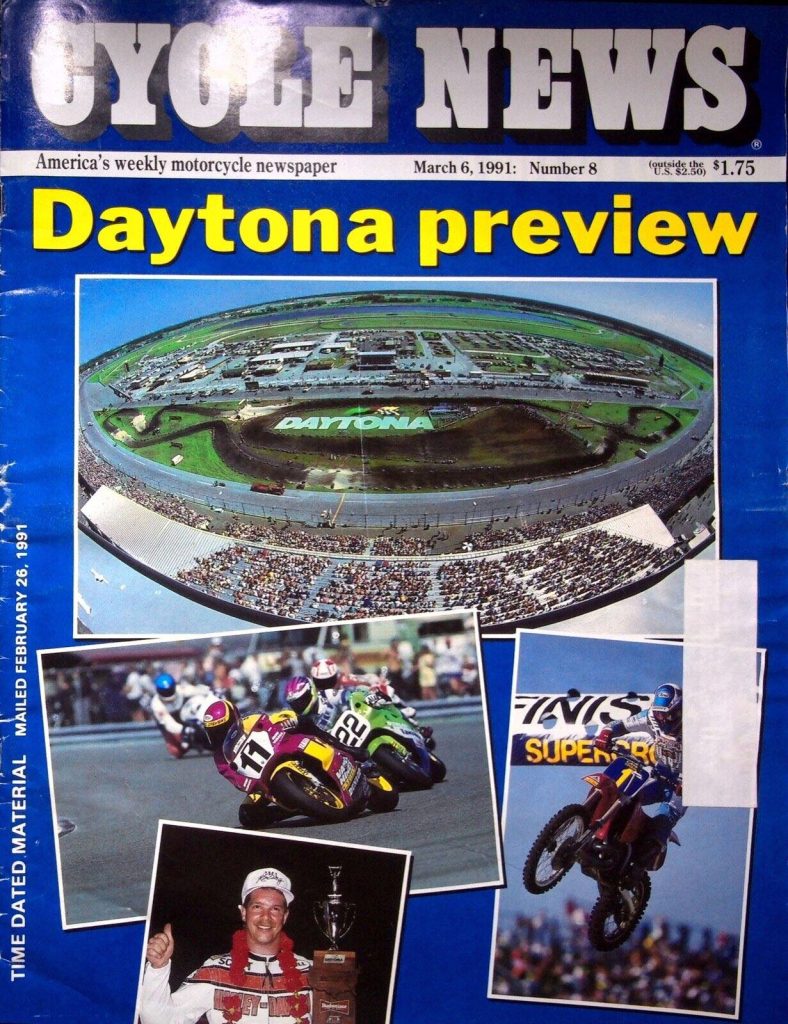 Like Dirt Rider, Cycle News always served many masters, and the 250 shootout did not even merit a mention on the March 6th, 1991 cover. Photo Credit: Cycle News
Like Dirt Rider, Cycle News always served many masters, and the 250 shootout did not even merit a mention on the March 6th, 1991 cover. Photo Credit: Cycle News
Because Cycle News wussed out on giving an official ranking of the contenders, I am only going to list the official shootout results for Motocross Action, Dirt Bike, and Dirt Rider. Both Motocross Action and Dirt Bike included the KTM in their final rankings, but Dirt Rider did not feel they had enough time with the Austrian machine to give it a fair shake in the standings. As before, I am going to give a brief rundown of each machine and let you know why the testers did or did not pick it as the best 250 racer in 1991.
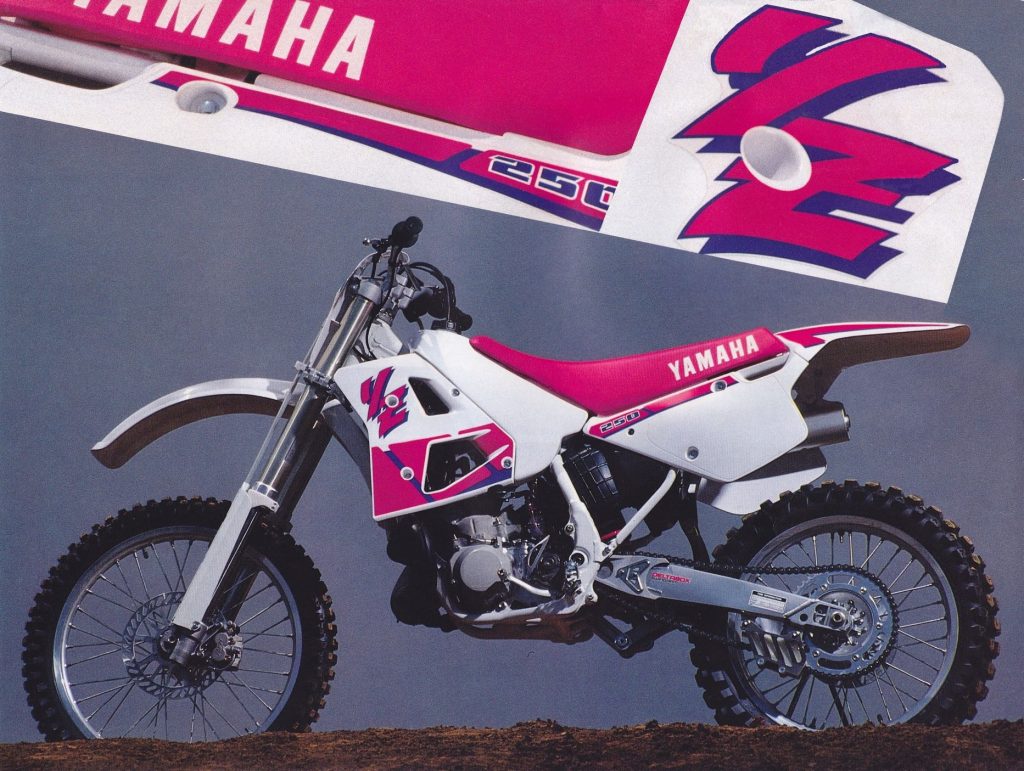 1991 Yamaha YZ250 Shootout Rankings: MXA – 1st (out of 5) Dirt Rider – 1st (out of 4) Dirt Bike – 2nd (out of 5) Photo Credit: Yamaha
1991 Yamaha YZ250 Shootout Rankings: MXA – 1st (out of 5) Dirt Rider – 1st (out of 4) Dirt Bike – 2nd (out of 5) Photo Credit: Yamaha
1991 Yamaha YZ250 Overview: The 1991 season was the year for major graphical overhauls and Yamaha got in on the party with all-new rear bodywork and a rather bold switch from their conservative red accenting to a shade of pink they insisted on calling “magenta.” The new rear fender and side plates gave the ’91 YZ a sleeker and more modern appearance that most riders thought was a significant improvement over the old fender design Yamaha had employed for over a decade. The switch to magenta was a bit more controversial, but compared to some of Yamaha’s rivals, the YZ’s new looks were positively understated.
Aside from the updated appearance, the YZ250 also received significant suspension and motor upgrades in 1991. All-new “works style” cartridge forks from Kayaba offered improved action and increased strength through a revamped damping system and a 2mm increase in fork diameter. In the rear, the YZ received an all-new “Deltabox” swingarm and redesigned Monocross linkage. Motor updates included a new longer stroke, an additional boost port in the cylinder, and a new slicker coating for the cylinder liner. An all-new clutch handled the additional power and a revamped shift mechanism looked to smooth out the Yamaha’s notoriously cranky transmission.
On the track, the 1991 YZ250 proved to be one of the most well-rounded and well-liked machines in the class. The overhauled motor offered an incredibly broad and easy-to-use spread of power that started pulling way down low and just kept on churning through a strong midrange. There was not as much hit as the Suzuki or as strong of a pull on top as the Honda, but it was super responsive, easy to manage, hooked up well on any surface, and never at a loss for power. Rev rangers lamented its relative lack of pull on top, and its transmission remained more stubborn than its rivals, but for most riders, it was an excellent motor package.
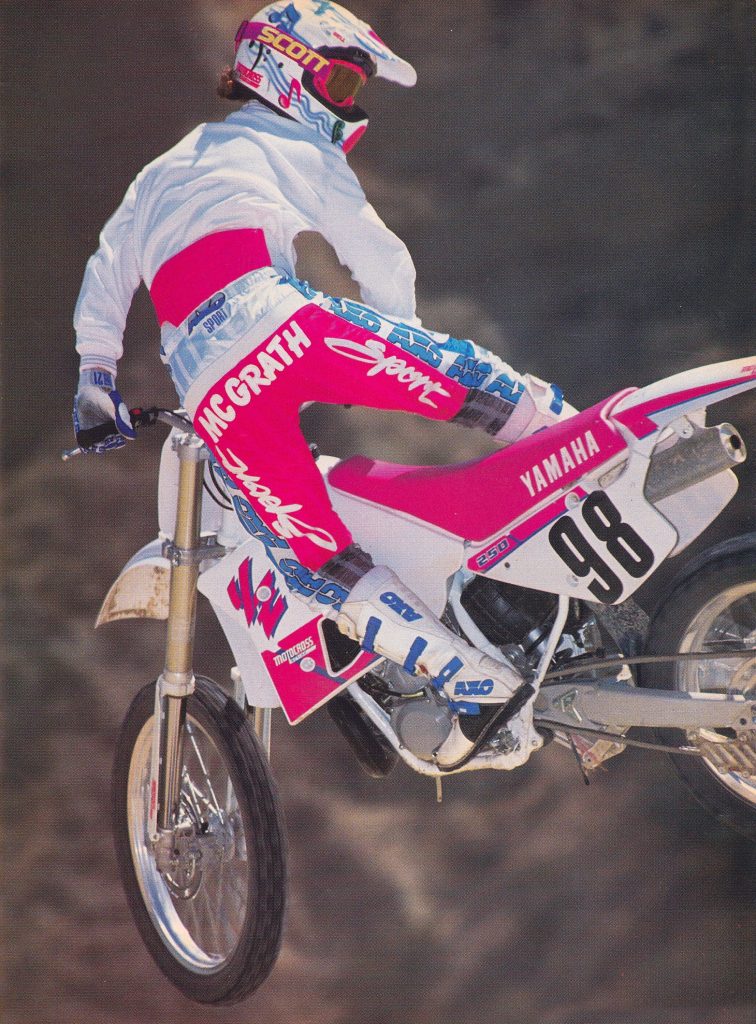 Not a standout in any one category, Yamaha’s 1991 YZ250 excelled by delivering the best box stock combination of motor, handling, and suspension performance in the class. Photo Credit: Motocross Action
Not a standout in any one category, Yamaha’s 1991 YZ250 excelled by delivering the best box stock combination of motor, handling, and suspension performance in the class. Photo Credit: Motocross Action
Like the motor, the Yamaha suspension and handling in 1991 were well regarded but not considered top of the class. The new 43mm KYB forks and revamped Monocross rear delivered a solid performance that was middle of the pack and raceable without too much fuss or fiddling. Most racers rated it below the ultra-plush Kawasaki’s performance but a quantum leap ahead of the harsh Honda and KTM. Handling was excellent overall, with very good stability and solid turning. Once again, the Yamaha took the Goldilocks approach by splitting the difference between freight trains like the Kawasaki and twitchers like the Suzuki. It was a great do-it-all chassis that was fun to ride and competitive on the track.
In the end, the YZ took the victory in two of three shootouts by being the most solid overall machine in the class. Its motor, handling, and suspension performance were not class-leading, but when you put it all together it offered the most well-rounded combination of box-stock effectiveness. MXA and Dirt Rider both felt that this was enough to elevate above its more exciting but flawed competitors. For Dirt Bike, however, this overall competence just wasn’t enough to push Bradshaw’s barnstormer to the top of the final standings.
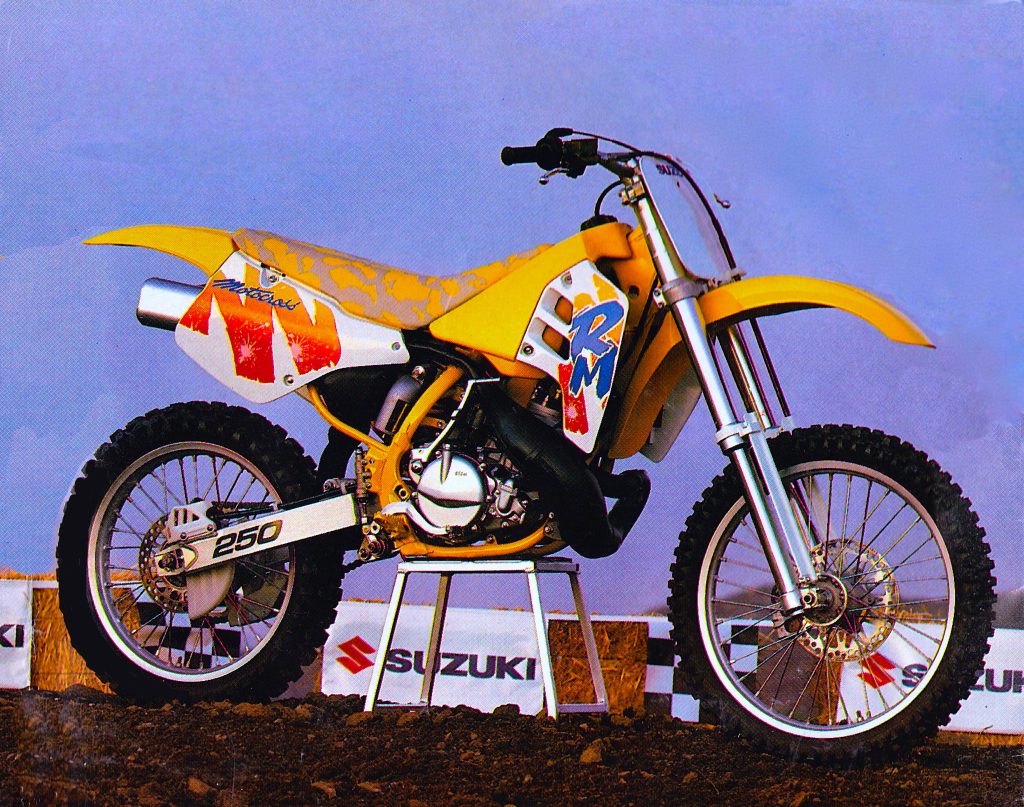 1991 Suzuki RM250 Shootout Rankings: MXA – 2nd (out of 5) Dirt Rider – 3rd (out of 4) Dirt Bike – 1st (out of 5) Photo Credit: Suzuki
1991 Suzuki RM250 Shootout Rankings: MXA – 2nd (out of 5) Dirt Rider – 3rd (out of 4) Dirt Bike – 1st (out of 5) Photo Credit: Suzuki
1991 Suzuki RM250 Overview: Early 1990s RM250s did not typically get a lot of love from the press, but in 1991, Suzuki bucked that trend by delivering by far the most well-regarded 250 Suzuki of the era. That season, Suzuki made the bold choice to switch suspension suppliers from Kayaba to Showa. Today, that does not seem like too big of a risk, but in 1991, Showa was coming off two seasons of absolute drubbings at the hands of the enthusiast press because of the abysmal performance of the 45mm inverted Showa units found on the CR250. Calling their performance grim was an understatement and many pit pundits questioned the wisdom of switching from the well-regarded KYB components to go with Showa.
Other than the move to Showa, the biggest shock of 1991 in the Suzuki camp was undoubtedly the machine’s new look. After two seasons of offering the prettiest machines on the track, Suzuki went full punk rock in 1991 with a graphics package that beggared belief. It was outlandish, colorful, and eye-catching. If the move was done to garner more eyeballs, it was certainly a success with most rider’s reactions varying somewhere between begrudging acceptance and utter incredulity.
Aside from its new suspension and fashion-forward looks, the RM was largely a refined version of the 1990 RM250. Chassis updates included a revised geometry and a new stronger swingarm. Motor refinements included a new O-Ring head gasket for improved sealing, revamped porting, revised timing for the AETC, a 5mm shorter intake tract, 10 percent more crank inertia, more efficient cooling, and upgraded gear dogs for the transmission. Aside from the color swap and kindergarten graphics, the bodywork remained unchanged from the year before.
On the track, the RM250 was significantly improved for 1991. Most surprising of all was the successful move to Showa which delivered far better results than Honda had been able to obtain the two previous seasons. The new 45mm forks and Showa shock were well set up and ranked as the best overall suspension package in the class by MXA and Dirt Bike. The revamped motor was hard-hitting and fast, with a powerful midrange and snappy delivery. It ran completely differently than all its rivals, but the power was competitive and very fun to ride. Its clutch pull was super easy, and its transmission was buttery smooth. The ultra-quick and hard-hitting power delivery made the RM a bit of a handful for less experienced riders, but even they rated it the best Suzuki motor since the move to case-reed in 1989.
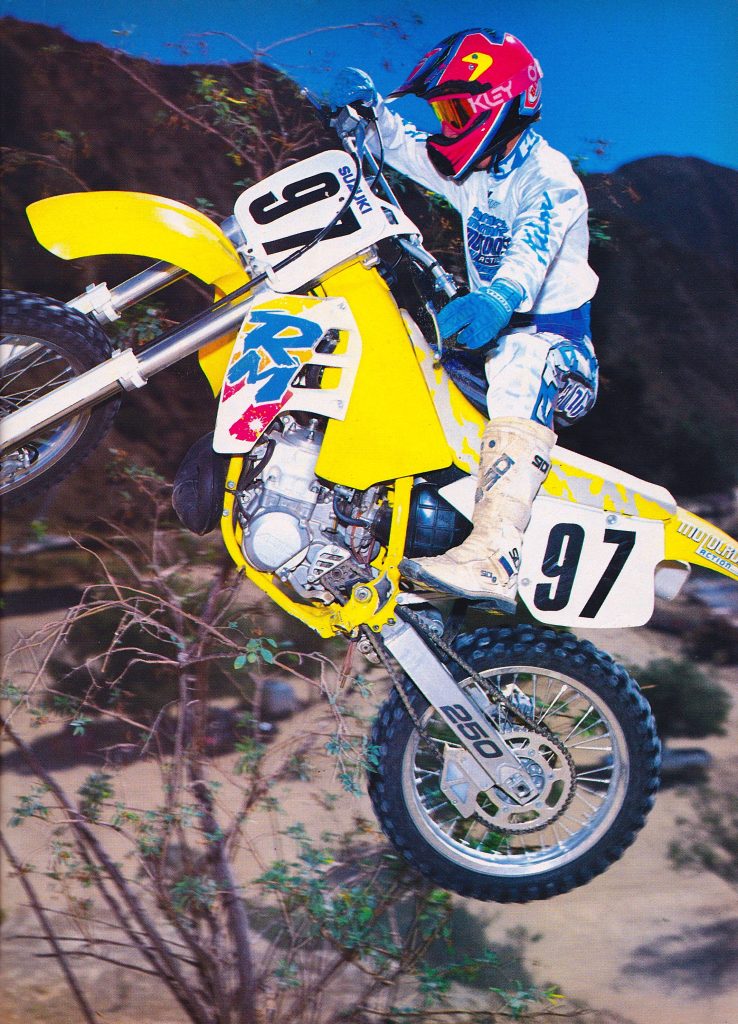 While its looks were polarizing, the 1991 Suzuki RM250 proved a consensus pick for the best Suzuki 250 since the excellent 1988 model. Photo Credit: Motocross Action
While its looks were polarizing, the 1991 Suzuki RM250 proved a consensus pick for the best Suzuki 250 since the excellent 1988 model. Photo Credit: Motocross Action
Overall handling remained skewed toward tight turning over stability, with the RM delivering the most responsive front end in the class. There was no need to climb all over the front end and pray for perfect weight positioning on the RM, just turn the bars and watch the Zook follow your whims. It was also the best jumper, with its snappy delivery and feathery feel in the air. No double was too steep or gap too large to conquer on the high-flying RM. At speed, the Suzuki remained quite busy and not everyone felt comfortable with its wandering nature. There was less headshake than on the Honda, but the RM could deliver its share of brown trouser moments if the track was fast and rough.
Overall, the RM250 had its best showing since 1988. The bike remained far more aggressive in its power and handling than some riders were comfortable with, but that did not hinder its final rankings in the minds of the Dirt Bike staff. They picked the RM as the top 250 of 1991 by virtue of its excellent turning, well-sorted suspension, and snappy power. They were quick to point out it was not a good bike for novices, but if you had the skill to make use of its potent performance then it was an excellent racer. Motocross Action ranked the RM second largely because of its busy high-speed manners and a motor that was less flexible than the Yamaha mill. At Dirt Rider, several of the testers liked the RM best, but others were never able to come to terms with its midrange-focused power and sketchy high-speed manners. In the end, a third overall was the best the RM could muster from the Wolfman and his crew.
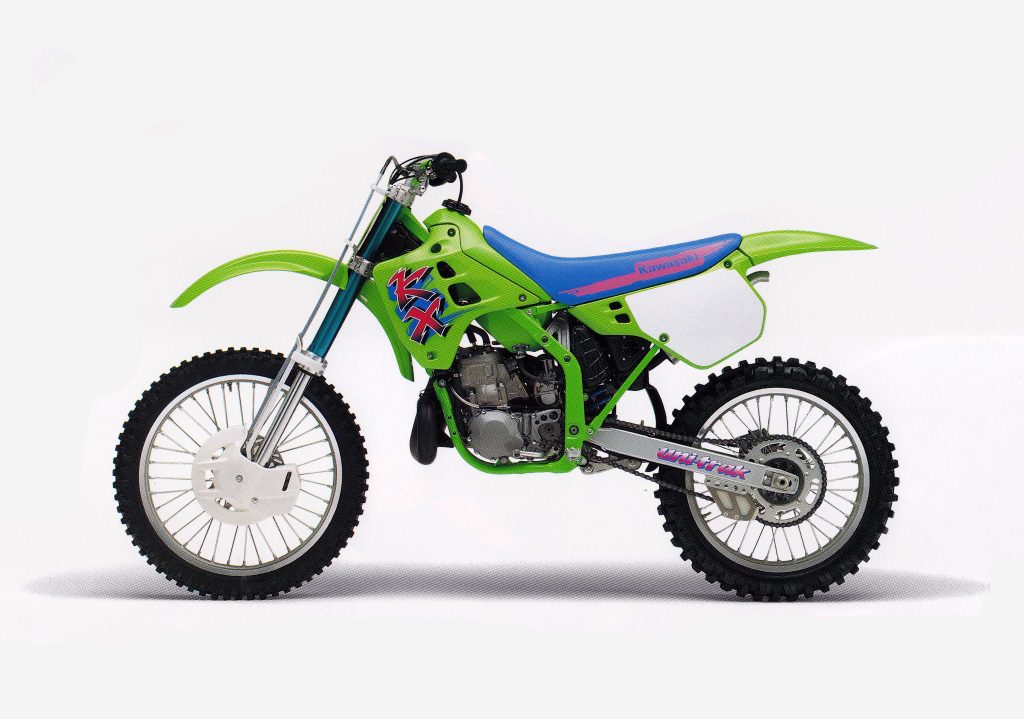 1991 Kawasaki KX250 Shootout Rankings: MXA – 3rd (out of 5) Dirt Rider – 2nd (out of 4) Dirt Bike – 4th (out of 5) Photo Credit: Kawasaki
1991 Kawasaki KX250 Shootout Rankings: MXA – 3rd (out of 5) Dirt Rider – 2nd (out of 4) Dirt Bike – 4th (out of 5) Photo Credit: Kawasaki
1991 Kawasaki KX250 Overview: In 1990, no machine in motocross was as buzzworthy as Kawasaki’s all-new KX250. Reimagined from the ground up, the KX shed its conservative roots with a radical new look and cutting-edge design. The KX’s trick perimeter frame, spacy bodywork, and blistering performance made it a favorite of racers and magazine editors alike.
In 1991, Kawasaki looked to build on this commercial success by refining the popular 1990 KX250 package. All-new Kayaba forks added a blue hue and an additional 2mm of diameter while additional bracing at the steering head helped beef up an already stout steel perimeter frame. Porting changes and a revised crank looked to broaden the ’90 machine’s hard-hitting delivery and an upgraded dual-piston caliper aimed to increase the bite of the front binder. Unlike most of the KX’s competition, Kawasaki chose to keep the graphics understated for 1991 with a modest update to the avant-garde ’90 model’s well-regarded looks.
On the track, the 1991 edition of the KX250 turned out to be a bit of a step back in the minds of many. In 1990, the KX was wicked fast, with tons of midrange hit and a howling top-end pull. For 1991, Kawasaki utterly transformed the KX’s powerband into a low-to-mid torquer that hooked up better out of slick turns but felt significantly slower everywhere else. There was a ton more grunt down low, but less juice in the middle and a reduced pull on top. The new motor might have actually been faster to the stopwatch if the track was hard and slick but virtually no one preferred it to the zestier 1990 powerband.
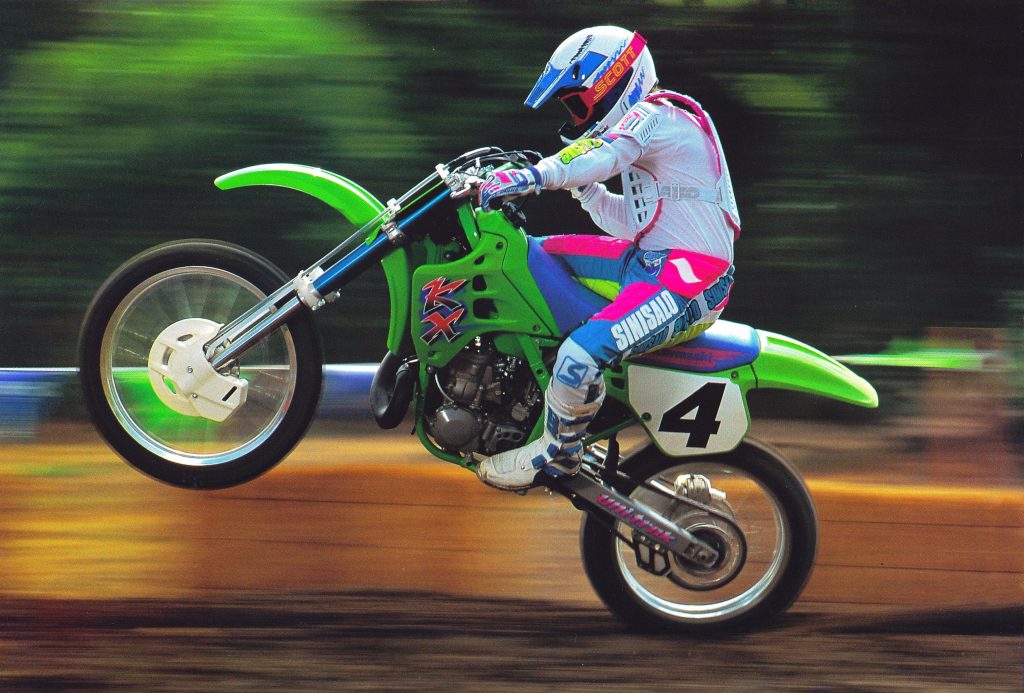 Kawasaki’s radical KX250 remained one of the coolest-looking machines in the class in 1991, but changes made to its previously potent motor left many riders pining for the missing hit of the 1990 machine. Photo Credit: Kawasaki
Kawasaki’s radical KX250 remained one of the coolest-looking machines in the class in 1991, but changes made to its previously potent motor left many riders pining for the missing hit of the 1990 machine. Photo Credit: Kawasaki
This slower and more tractor-like delivery only exacerbated the large and heavy feel the KX exhibited on the track and riders that overlooked it the year before began grumbling about the Kawasaki’s portly dimensions. The steel perimeter frame was remarkably strong, but its wide spars and tall steering head made the bike feel large and unwieldy at times. Stability was fantastic and the KX was not a poor handler overall, but it took considerably more effort to stick to the inside line compared to the RM, CR, and YZ. If you got lazy or tired and failed to use proper body positioning, then the big Kwacker liked to stand up and climb out of berms. Taller and stronger pilots had fewer issues with this, but the big and tall KX was not a great fit for everyone.
Of all the KX’s virtues in 1991, its most significant was its front suspension. Riders raved about the plushness of the KX’s forks, and many riders rated it the best front end of the 1991 machines. The rear shock was not as universally praised as the forks, but Dirt Rider did rank the KX ahead of the RM for best overall suspension package in 1991. For most riders, the KX’s excellent suspension was just not enough to rank it ahead of faster and better-handling machines. Riders who gelled with its plus-sized feel were big fans of the KX, but they were far from the majority in 1991.
Overall, the KX250 turned out to be a bit of a disappointment in 1991. The revamped motor was easier to ride but it felt slow, and this made the KX’s design flaws more apparent. With its excellent suspension, phenomenal looks, and rock-solid high-speed handling the KX was far from a lost cause, but in the minds of many the 1990 version was a better machine.
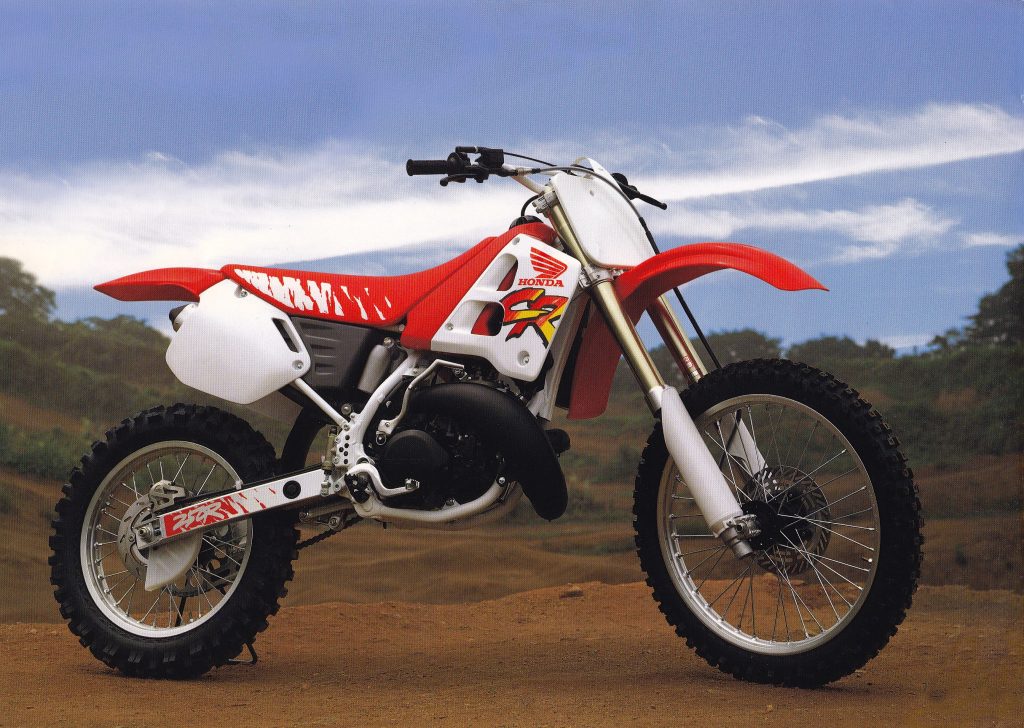 1991 Honda CR250 Shootout Rankings: MXA – 4th (out of 5) Dirt Rider – 4th (out of 4) Dirt Bike – 3rd (out of 5) Photo Credit: Honda
1991 Honda CR250 Shootout Rankings: MXA – 4th (out of 5) Dirt Rider – 4th (out of 4) Dirt Bike – 3rd (out of 5) Photo Credit: Honda
1991 Honda CR250R Overview: Looking back now, it can be hard to imagine that the Honda CR250R finished so poorly in all the major shootouts of 1991. After all, it offered the broadest and most powerful engine in the class, featured the best build quality, second-to-none reliability, and impeccable turning manners. Its ergonomics, brakes, clutch, and transmission bordered on perfection and its reputation for winning was unmatched. It easily captured the 1991 Supercross and 250 National Motocross titles and remains today the most sought-after machine of its era. With all this going for it, how in the world did it finish third, fourth, and fourth? One word – suspension.
Despite the CR’s many virtues, it was impossible to overlook the utter ineptitude of Honda’s suspension testing department in 1991. After being lambasted the two previous seasons for their awful suspension, Honda made the bold move to switch to Kayaba for their rear shock supplier in 1991. The front forks remained Showa’s jaw-jarring 45mm inverted units but out back Honda threw in the towel and went shopping across town at KYB. The result was a slightly better, but still not very good suspension package for 1991.
Up front, Showa tried to save face by redesigning the cartridge mechanism, upgrading the bottoming system, and treating the inner tubes with an Alumite coating to prevent the particulate contamination that had befouled their damping the two previous seasons. In addition to the new KYB rear damper, Honda also upgraded the linkage for 1991 by adding new low-friction Teflon bushings and spherical bearings. Honda claimed the new linkage components reduced friction by 50% over the 1990 design.
Aside from these suspension updates, the CR250R was virtually unchanged from the year before. The motor, frame, brakes, and bodywork were all unchanged aside from a swap in color to white for the shrouds and some very un-Honda-like new graphics. Compared to the craziness of the ‘91 Suzukis, the CR’s new graphics and tiger-striped seat seem pretty tame, but it was a significant departure from the ultra-clean monochromatic look of the 1990 CRs.
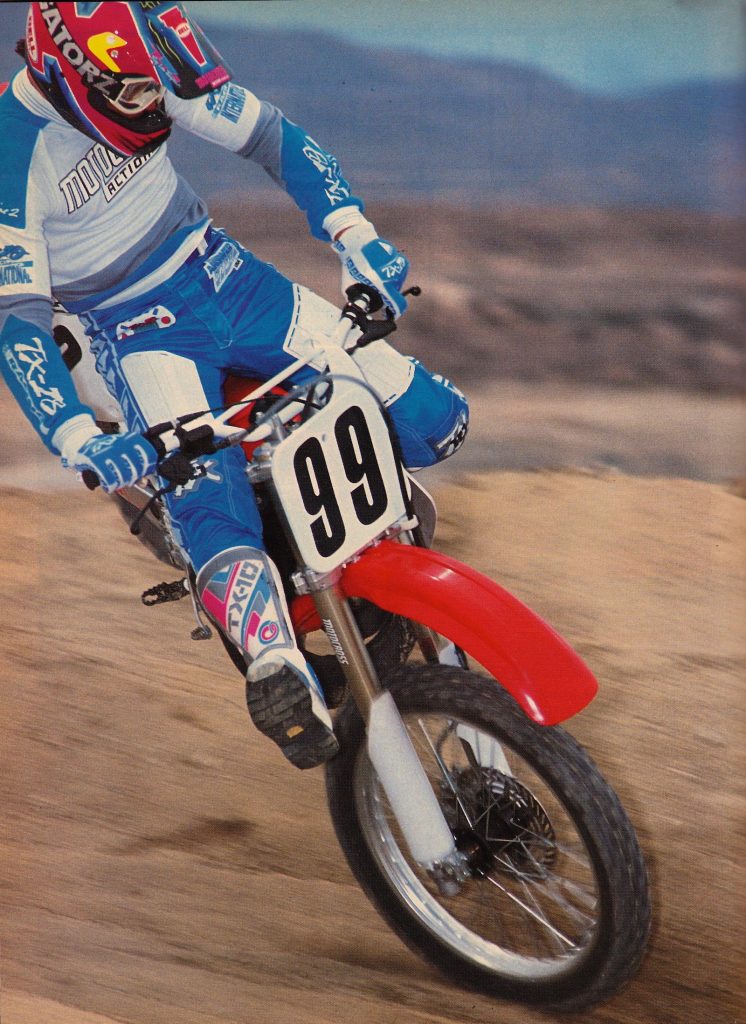 The fastest, winningest, and best-built machine in motocross was a decent fork away from being the alpha dog of the 250 class in 1991. Photo Credit: Motocross Action
The fastest, winningest, and best-built machine in motocross was a decent fork away from being the alpha dog of the 250 class in 1991. Photo Credit: Motocross Action
As in 1990, the CR’s final shootout standings came down to its subpar suspension. The Honda’s forks were a tiny bit better for 1991 but they remained the Medieval torture devices of the 250 division. Big hits were taken well, but everything short of a Supercross triple pounded the rider’s hands to a pulp. This was not too bad on the first lap when you were aggressive and charging but by lap three, the Honda’s constant abuse usually resulted in severely pumped arms, sore hands, and rattling teeth.
Out back, the new KYB damper was improved, but once again it demanded Jeff Stanton’s levels of aggressiveness to work properly. Backing it down even a little bit resulted in the shock hammering you in the backside. It loved big jumps and mega whoops but averted its eyes when presented with small chatter, chuck holes, and braking bumps. Really fast guys could make this work by skipping and hopping over the bumps, but most mere mortals found the CR’s stock suspension to be torturous.
Other than its grim suspension, however, the 1991 CR250R was an absolute gem. The motor was unbelievably broad, remarkably flexible, and incredibly fast. The CR could do things in one gear that would demand a rider on the RM to make three shifts. There was always power on tap and the Honda’s electric delivery made it easy to apply every one of those ponies to the track. The clutch pull was not as easy as the RM’s, but it was far better at taking abuse and the transmission was perfectly spaced and never missed a shift. Riders loved the CR’s super-slim layout, comfortable seat, flawless grips, and bulletproof controls. The brakes stopped on a dime and never seemed to need bleeding. The CR’s chassis was second only to the Suzuki in the turns but like the RM it was a bit of a Tilt-A-Whirl at speed. Headshake under deceleration could be of the Biblical variety and it was always a good idea to cinch down the steering head to put a little resistance into the front end.
Overall, the 1991 Honda CR250R was an absolutely incredible machine saddled with atrociously flawed suspension. If it had even passably good forks, it would have been unbeatable, but in stock condition, it was only the third or fourth-best 250 available in 1991.
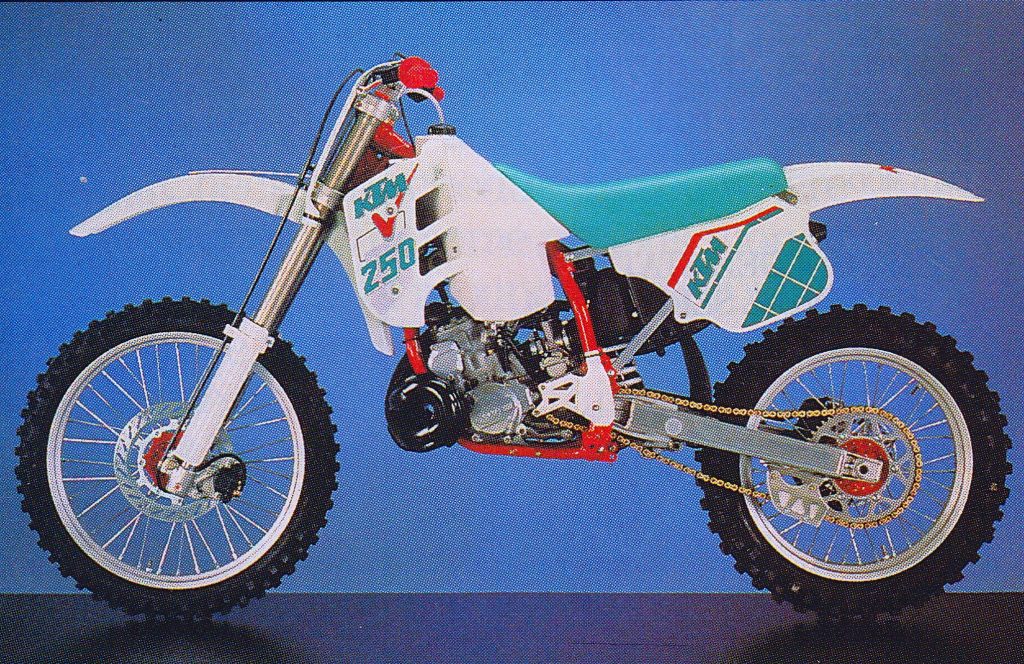 1991 KTM 250MX Shootout Rankings: MXA – 5th (out of 5) Dirt Rider – N/A Dirt Bike – 5th (out of 5) Photo Credit: KTM
1991 KTM 250MX Shootout Rankings: MXA – 5th (out of 5) Dirt Rider – N/A Dirt Bike – 5th (out of 5) Photo Credit: KTM
1991 KTM 250MX Overview: In 1989, KTM made major strides towards breaking into the US market by completely redesigning their 250 motocross machine. The Austrian brand hired American motocross legend Broc Glover to race and develop the new machine and released it in 1990 to significant fanfare. The all-new 1990 250MX looked and felt more like a Japanese machine, with Honda-esque styling, comfortable ergonomics, and a right-hand kicker. Riders praised the look and feel of the new bike, but its poorly set up White Power suspension and mild power output torpedoed its chances in the final standings.
In 1991, KTM updated the 250MX with an all-new look they coined “Mint & Pepper.” This new mint green color combo joined the parade of bold looks for 1991 and certainly helped the Katoom stand out from its rivals. In addition to the updated graphics, the 250MX received a new seat which featured a non-slip “sand-grip” texture for additional grip and a revised shape for improved comfort. White Power remained the suspension supplier, but all-new low-friction bushings were added and paired with revamped valving front and rear. Motor changes for 1991 included revised porting, a new ignition, updated settings for the TVC exhaust valve, and a reshaped exhaust.
On the track, the 1991 KTM 250 was a surprisingly competitive machine. The motor updates boosted low-end power considerably and the KTM offered the chunkiest low-to-mid powerband in the class. It barked out of turns and snapped to attention at the first crack of the throttle. There was considerably more power on tap than the year before but the powerband tapered off steeply after the midrange. There was virtually no top end, but the KTM ‘s motor was plenty competitive if ridden correctly.
Where most riders fell out of love with the KTM was once the track got rough. Despite the new slicker bushings and revamped settings, the White Power suspension continued to fall short of most rider’s expectations. In stock condition, the forks and shock were rated the worst in the field by MXA and Dirt Bike. Considering how bad the Honda’s stock forks were this was no small feat. Some of the editors at Cycle News had fewer qualms with the shock, but overall, this was the KTM’s true Achilles’ heel. The KTM’s handling was also out of step with many rider’s tastes but this was far less of an issue than the stock WP suspension. Stability was pretty good but the 250MX exhibited a push in tight turns that made it hard to trust the front end. It was nimbler than the Kawasaki but not in the same handling class as the Honda and Suzuki. Overall, it was a decent handler that took a bit of time to adapt to.
In the end, the 1991 KTM 250MX was a competitive machine that still needed a bit of fine-tuning to please the tastes of most American testers. The motor was fun, fast, and a huge improvement over the year before. The handling was no standout, but it was good enough to get the job done and the suspension could be made to work by a knowledgeable tuner. Mike Fisher’s results in Supercross showed that the KTM could be a contender, but in stock condition, most of the magazine editors felt the KTM’s suspension was too much of a handicap to overcome.

